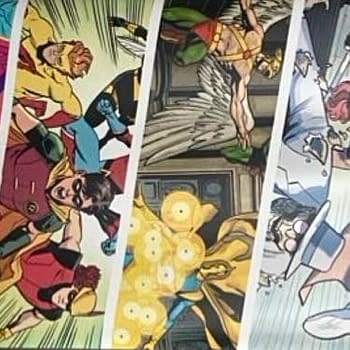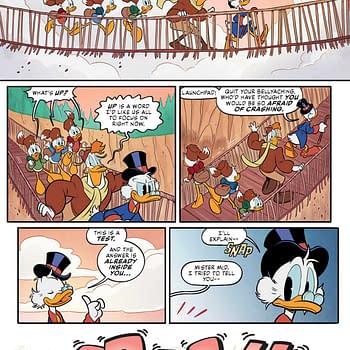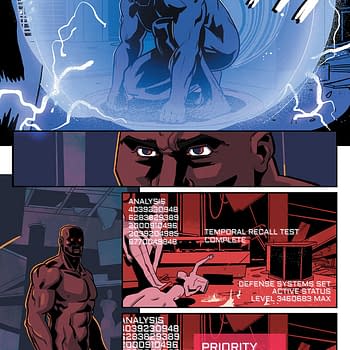Posted in: Comics, Recent Updates | Tagged: Avengers: Rage of Ultron, Avengers: Ultron Forever #1, Convergence #0, Earth 2: World's End #26, The New 52: Futures End #48, UFOlogy #1
Thor's Comic Review Column – The New 52: Futures End #48, Earth 2: World's End #26, Convergence #0, UFOlogy #1, Avengers: Rage Of Ultron, Avengers: Ultron Forever #1
This Week's Reviews:
The New 52: Futures End #48
Earth 2: World's End #26
Convergence #0
UFOlogy #1
Avengers: Rage of Ultron
Avengers: Ultron Forever #1
The Ends of the New 52 (Converging on a new beginning)
By Graig Kent
The New 52: Futures End #48 (DC Comics, $2.99)
Earth 2: World's End #26 (DC Comics, $3.99)
Convergence #0 (DC Comics, $4.99)
[*Warning: Spoilers for Futures End, World's End and Convergence]

Futures End began in a Terminator-esque future where the satellite Brother Eye had virtually eradicated humanity by taking them over, converting them into a hive of cyborgs which he controls. Only a few humans remained alive. Of them, Terry McGuinness, Batman Beyond, took the fateful trip into the past, Kyle Reese-style, to try to prevent this future from ever happening. The penultimate issue of the series found McGuinness dead, and Tim Drake donning the Batman Beyond suit. Drake took another time jump in to the past that seemingly succeeded in destroying Brother Eye, but not before the satellite propelled him into the future. This issue, Drake discovers that he has arrived almost exactly where Terry McGuinness left, the only thing that's truly changed between the first issue and the last is who is inside the costume. The book concludes with no triumph and no resolution, just a few surviving humans still looking to salvage humanity and conquer their cybernetic overlord.
Disappointing doesn't even begin to describe this conclusion. I flipped the back pages of the comic (comprised of the credits page and advertisements) back and forth incredulously, looking for the rest of the story or for some sign that this wasn't the end, turning up nothing. What is unsaid (and I had to dig around online and suss out for myself) is that the June arrival of Batman Beyond #1 (written by Futures End co-writer Dan Jurgens) is in all probability a direct continuation, which is even more aggravating that a series that has eaten up 90 comics worth of real estate largely serves only as a lead into another series.
When 52, DC's first big weekly back in 2008 concluded, its four writers managed to bring their various storylines together to a great big head, and change the landscape of the DCU going forward, and wrap it all up in a vastly satisfying finale. It didn't end with cheap cliffhangers or an anti-climax in order to sell a new title (but still managed to spin off a new book or two unforced).
Futures End didn't live 30 years in the future, it just started and ended there. Its main tales take place in a 5-years-from-now that will never come to exist. But unlike 52, there was no denouement. Some storylines ended over ten issues back, virtually forgotten save for a small coda in the six issue run to the finish. The Amethyst and Frankenstein arc, for instance, ends with Frank dying and Amethyst resolving to take back Gemworld (this in a future that shouldn't exist because of the events of issue 47). Or the Cadmus Island arc which introduced an entertaining new character in Fifty-Sue (and made a family for her out of Grifter and Earth-2 Lana Lang) who can't exist in the DCU mainstream because she was a result of experiments on Earth-2 refugees, and Tim Drake prevented the refugees from arriving on this Earth (which makes me wonder, is this now one of the unidentified Earths from Morrison's Multiversity Handbook? Or is it a lost alternate timeline?).
From the start of this series we all figured that this would be a self-contained story. Taking place 30 years and 5 years in the future, the expectation was that these were never going to be actual futures, thus this was just a weekly series that would give us an exciting "elseworld" to invest in. Any reader who invested all the way to the end was certainly willing to make this conceit. We were all just looking for the story of how this faux-Skynet was overcome, only to get sucked into an alternate DCU reality filled marginalized Earth-2 refugees and a mysterious threat from deep space. To end it the way it did, and to continue one character's journey in an ongoing series, doesn't validate Futures End in the DCU continuity so much as it invalidates the initial pretense in which the reader was willing to invest.
—

The conceit for World's End finds Earth-2 besieged by the forces of Darkseid, with his planet of Apokolips literally consuming the Earth's resources, and its very essence. The most powerful heroes of this Earth — Power Girl, Green Lantern Alan Scott, Red Tornado Lois Lane (yeah, you read that right), Superman Val-Zod — are helpless to stop the relentless onslaught of parademons and furies, while its powerless and more cerebral heroes — Batman Thomas Wayne, Huntress, Red Arrow, Mr. Terrific, Mister Miracle and the people of the World Army — endeavour to find a solution for saving humanity if not the planet.
Where Futures End worked through multiple character arcs and storylines, building its own version of the DCU populated with a cast of intriguing characters and organizations, creating meaningful relationships and viable dynamics, the events of World's End were largely in service of one story, where character development and relationship building seemed to be a puzzling maze to stumble through, reaching dead ends, turning around, and trying from a different approach. There's so much nonsense and repetitive ground trod in World's End that it really should have been able to reach the same destination in a much more compressed manner.
It's not that Earth-2 isn't populated by enough unique and distinct characters that it couldn't pad out a 26-issue series dealing solely with the Apokolips invasion, but the book's awkward execution likely a result of story runner Daniel H. Wilson's inexperience writing for serialized comics (this is his first comics gig besides a Zombies vs. Robots short in 2006). Even bolstered by a team consisting of Marguerite Bennett, Mike Johnson and Cullen Bunn, Wilson's story at all times seems overwhelmed by the demands of trying to break it down among multiple characters over 26 parts.
Alan Scott is the spotlight character in the series. Spinning on the New 52's Swamp Thing and Animal Man mythology, Scott's power comes from the elemental "Green" of the Earth. As Apokolips begins to infect the Earth he feels his power source in flux and gathers together the other avatars (of Red, Grey, White and Blue), only to find their power wanes, even combined. So they combine all their power together, and Scott becomes the sole avatar of the Earth, still to find he's not powerful enough. In this final issue, Scott pulls together the powers of multiple Earths, becoming a sort of avatar of multiversal Earths, still to find that he's not powerful enough to stop Darkseid (even though he takes one very impressive shot at it). Compressed, it would be a good example of how tough the fight against Apokolips is, but spread across 26 issues, it's tedious and repetitive, with Scott hitting the same emotional beats over and over again.
The dialogue in the series is likewise repetitive, with the characters frequently repeating their objectives or sole concern to the point of annoyance and aggravation. Power Girl in the early stages is only concerned with Helena's whereabouts, Jay Garrick in the later stages is solely concerned about his mother's safety, except when he isn't. Multiple characters seem to flip-flop between good and bad; hoary old tropes (like killing badass police officer Barbara Gordon so that her ineffectual husband Dick Grayson can become a hero, likely Batman) are groan inducing; and dialogue is often so tone deaf that the heroes seem oblivious to the horrors befalling the Earth around them. Character development, in some instances, is as simple as putting an emblem on someone's chest.
The art comes from a variety of sources each issue. Where Futures End had a rotating roster of artists each handling a full issue at a time, Earth's End rotated their artists by story line, such that each issue featured four or five different pencilers (in this extra-sized final issue there's eight) all of varying — and not often complementary — styles. Scott McDaniel had been credited with breakdowns up until issue 24, which theoretically should have provided some storytelling consistency, but when the script is as disjointed as this is, and the artistic styles keep shifting, that consistency did not translate. Editorially, even, there are lapses, such as Power Girl gouging Darkseid's eye out in issue 25, but it's back and functioning on page 1 and for the rest of issue 26. Both the one-artist-per-issue and one-artist-per-storyline methods have their flaws, and consistency in style (and often visual continuity) is a problem for both. With weeklies like these, the art tends to be a distant third consideration to the writing, which itself is somewhat a distant second to the story. There shouldn't be a lot of room for individuality across the board, it creates disharmony in the storytelling. Where having one artist per issue of Futures End makes it a bit easier to read as a stand-alone issue, the visual differences becomes stark when reading multiple issues in one sitting. The multiple artists per issue in World's End serves each storyline better in a concentrated reading of the series, but issue-by-issue it exacerbates the already disjointed scripting and pacing problems.

Earth 2: World`s End should have been an absolute epic, an intense story of fighting for survival, of failure, and of tremendous loss. All that is in there, but obscured within a muddled mass of tediousness and awkwardness.
—
"He wants to take a city from my Earth and place it here?" Superman asks.
"Of course," replies one of the forms of Brainiac the sentient planet has manufactured for Superman's benefit.
"But he never returned," continues another.

Kicking off yet another weekly series (this time only 9 issues over two months), this issue introduces the idea for the Convergence schedule-filler event by loosely tying it into some other things that have gone on around "The New 52" (it should be noted that this is the first in-continuity book to not feature "The New 52!" on the cover since the reboot). Likewise it also kind of explains why "The New 52!" universe (put on hiatus for two months due to DC headquarters' move to the west coast) isn't going to actively participate or be affected by Convergence.
The book opens with Superman facing yet another monstrous iteration of Brainiac, only to find his nemesis keeps changing shape and form. Though none of the visages are recognizable to him, the reader is treated to all manner of renditions of Brainiac from the past. Superman is being held captive, unsure why he is imprisoned on a sentient planet outside of reality. He learns Brainiac has manipulated this planet to serve as a home for captured cities from times and dimensions whose existence is threatened, and that he left to capture a city from Superman's reality, never to return. Since Superman has no place, he is ejected from the planet, returned to his home, his memories redacted.
That explains the plot in a nutshell, but the execution is a little more sophisticated. Reading this immediately after the ends of Futures End and Worlds End I was feeling a little dejected, somewhat angry. I wasn't optimistic for yet another event, nor was I expecting to find anything more than filler. However, Convergence #0 writers Dan Jurgens and Jeff King craft a grand cosmic-tinged story, complete with confusing double speak and an unhelpful guide. Yet, it's a story that's grounded by Superman's confusion, anger, distrust, and desire to get home. Though not nearly as successful, there seems to be an indirect influence of Grant Morrison's Final Crisis: Superman Beyond mini-series, putting Superman in an exceptionally alien domain, confronting him with theories of surreality.
Even more, there's an element of the classic 1960s' The Prisoner TV series to this, where Superman battles with his jailer, trying to make some sense of the words being spoken to him, and also just looking for any angle that may give him an advantage. Superman here is at the mercy of the living planet outside reality, whatever he says or does is largely ineffectual, just as Number 6 was at all times subject to the whims of the Village. Similarly, Superman is prone to fits of violence while his opposition is attempting to make conversation, just as Number 6 was. Likewise, just as Number 2 was looking for answers from Number 6, for which he received none, so too is this living planet turning to Superman for answers, but Superman has none to give.
Much of the success of this unusual conversation must be credited to Ethan Van Sciver (who also illustrated the zero issue of Futures End, it should be noted). He delivers a thoroughly puzzled, angry, shocked, defeated, and resolved Superman page after page, showing a man ready to carry the weight of any world on his shoulders. Even though his grizzled stubbly face atop his shiny, piped costume has a strangely incongruous effect, especially when put up against the splash page of Superman deaths across time, this feels like a benchmark New 52 Superman comic. It does highlight how much more aggressive the New 52 Superman is, less prone to fighting cerebrally with foes evidently more powerful than he. Van Sciver puts Superman in all manner of delightfully visual environments, his Inception-styled cityscape double-splash page is gorgeously rich in detail, but just as stunning is the much smaller panels of Superman emerging into a vacant yet obviously alien desert (credit in both sequences must be given to Marcelo Maiolo, whose coloring is nothing short of masterful, creating a vibrant, enticing look that at once feels both modern and retro).
In the way this issue rapidly gets away from –or rather avoids altogether– being mired in the continuity of one event or another (ergo, Doomed or World's End or Futures End) it actually serves well as a stand-alone introduction to what's about to come. I doubt, based on covers and solicits for the 8-issue series to come, that the feel of this introduction will sustain to Convergence proper, but it's a surprisingly decent introduction to the concept at play.
Graig Kent is still waiting to see if the enjoyable Smallville Season 11 will dovetail into Convergence as well, while trying not to tabulate the total cost of purchasing Futures End and World's End. He tweets occasionally @thee_geekent and wrote a superhero(ish) novel called Quarter City, free to read on Wattpad.
UFOlogy #1 (Boom!, $3.99)
By Cat Taylor

UFOlogy's debut issue gets off to a slow start by introducing us to a small town high school and the main character, Becky Finch. Becky seems to be a sort of "troubled teen" who let her potential go a year ago for reasons that have yet to be explained. She also comes off as a loner who doesn't really like a lot of people, and she's easily the most fully developed character in the whole book. The rest of the cast all show hints that they will play significant roles in future issues, but we don't get a lot of information about them at this point. That's the kind of mystery that the writers and creators, James Tynion IV and Noah J. Yuenkel create. There are a lot of hints and loose threads dropped in this issue that should make most readers want to come back for more. Therefore, if this issue fails to hook people for the next chapter, I can only assume that it's due to a lack of interest in the characters themselves. While I expect further development of all the characters is coming, an impatient reader may not stick around. Also, while excitement is lacking in the early pages of this issue, it is made up in spades during the last moments where things go nuts.
When it comes to the talent behind UFOlogy, there is a mixed bag of experience. Tynion is a very accomplished writer, who has written major titles for Marvel and DC as well as many of the stranger and more interesting works from Boom! On the other hand, his friend and co-writer/co-creator, Yuenkel, doesn't have a lot of accolades to his name according to the Google machine. So, it's hard to tell how much he contributed. The writing style definitely reminds me of some of Tynion's other work though.
In the art department, Matthew Fox does a nice job of illustrating characters, scenery, and motion. He's not too experimental with panel placement or structure, but who cares? A lot of the artists who do that kind of thing are like drummers who play solos anyway. Stylistically, Fox's work reminds me more of the Japanese anime drawings than the work of traditional American comics. His illustrations benefit greatly from the vibrant colors used by Adam Metcalfe. If that name sounds familiar to you, it's because he's colored just about every book that Boom! has published in the last year. It seems that Metcalfe has a monopoly on colored ink or something, but since he's the only colorist whose work I can recognize without looking at the credits page, he must be doing something right. Also, his use of oddball hues is a perfect fit for the kinds of stories that Boom! has been publishing lately anyway.
This group of talented creators and artists has created a comic that shows a lot of potential to be a sleeper hit with readers. Although the subject matter is hardly unique, the TV series pacing and reveals in the first issue could potentially convert a lot of non-comics readers. Future issues should answer the many unanswered questions that have been asked by issue one. I just hope that the answers keep the suspense building for a super-exciting final issue.
Cat Taylor has been reading comics since the 1970s. Some of his favorite writers are Alan Moore, Neil Gaiman, Peter Bagge, and Kurt Busiek. Prior to writing about comics, Taylor performed in punk rock bands and on the outlaw professional wrestling circuit. During that time he also wrote for music and pro wrestling fanzines. His bio says that same crap every week. You can e-mail Cat at cizattaylor@hotmail.com. It says that every week too and that's why there's a lot more spam in his inbox than there used to be. Thanks a lot internet bots!
Avengers: Rage of Ultron (Marvel, $24.99)
Avengers: Ultron Forever #1 of 5 (Marvel, $4.99)
By Jeb D.
Ultron comin', yo…
*whistles*

Marvel doesn't do a lot of standalone graphic novels, so quite apart from the movie tie-in, Rage of Ultron represents something of an occasion: either it's a nicely self-contained showcase for Assemblers old and new against one of their deadliest foes, or it's an extra $25 price tag for a story that could probably have run just as well in a few issues of Uncanny Avengers… and since I wouldn't say that it's exactly self-contained, you can see where that leaves us (FWIW, I borrowed a copy to review it).
Though as a "complete" story, Rage of Ultron should stand on its own, it does benefit some from a reader's familiarity with Remender's Uncanny Avengers (among other things, The Descendents are key players), but lapsed fans can ease in as the first half of the story reaches back to the days of furry blue Hank McCoy, Yellowjacket-era Pym and Janet, and The Vision.
Remender's basic premise here isn't bad: Ultron is not only once more on the rampage, but in the wake of yet another disastrous attempt by Hank Pym to rectify having created the monstrous robot, the question is raised of whether Ultron and his kind are technically "artificial intelligence," and if they are, is their destruction justified? Does artificial intelligence deserve the same respect as that which is created more "naturally"? It's an interesting discussion (though one that, oddly, I seem to recall Pym being on exactly the opposite side of in Avengers A.I.) and goes some way toward justifying the larger-format of this story, because it gets a LOT of discussion. Taken as a whole, the book is fairly well-paced between various characters rationalizing their view of the question, and huge, gloriously manic fight scenes, but if it had been broken up into individual issues, a few of them would have felt awfully talky. Opena and Larraz actually alternate throughout the book, and while they're certainly not indistinguishable from each other, they mesh well enough that the flow of the action is never interrupted, even when the flow of the storytelling comes to a halt for another argument between Hank Pym and those Avengers who didn't actually cause all the trouble by creating Ultron in the first place. There's nothing particularly innovative about Opena and Larraz's work, but it's so solid and thrillingly kinetic that I could almost recommend the $25 volume for that alone. And I always enjoy the odd little touches that Remender throws in (somehow, it's just perfect that Air is Starfox's go-to makeout music). But for a self-contained story, the overall plotting winds up being rather unsatisfying, with Ultron's inevitable comeuppance being delivered via… well, via the power of love. And though this book is, in theory, in continuity (whatever that means these days), it ends up in an odd place for some of the key players going forward, particularly given the line-wide reshuffle on the way.
Kurt Busiek provides the book's introduction, laying out the family dynamics at work: Pym to Ultron to Vision. It winds up making some of the plotting feel a bit on-the-nose as a result, but I always enjoy reading Busiek on Marvel, even if it's been a while since he's had any actual involvement with the characters.
Not unlike Rage of Ultron, Ultron Forever assembles (so to speak) its cast of characters from different eras, but employing a time-travel/alternate universe playbook: in addition to Black Widow, we get Simonson-era Thor partnering with current female Thor, Jim Rhodes as Iron Man, and classic 60's-era Hulk; the highlight of the cast is a grown-up Danielle Cage (daughter of Luke and Jessica Jones) as the "Captain America" of her timeline/universe, and in the book's "pre-credit" sequence, she's up against the foppishly-dressed villain "The Golden Skull": it's wonderful pulpy fun, and Davis makes it as visually exciting as any Steve Rogers or Sam Wilson action scene. Detailing just how, and by whom, these characters are brought together would be on the spoilery side, and while I don't shy away from spoilers in principle, in this case it's not really relevant: whether the particular details of this plotline pan out or not (and I have a few reservations already), I'm having a blast just seeing these oddly-assorted characters interact; where Remender seems to be shoehorning some of the cast into his story (If nothing else, Sabertooth's appearance in Rage of Ultron demonstrates that there were worse things than having Wolverine as a member of the Avengers), Ewing and Davis' team immediately feels almost as natural and organic as any Avengers unit I can recall. And if the end of Rage of Ultron is arguably its greatest weakness, the end of Ultron Forever #1 is the kind of full-page reveal that brings a giddy, goofy smile to this veteran Marvel maniac's heart.
The art is everything you want from Davis, from the punch-ups and throwdowns to the quieter character moments and highly distinctive facial work (his Hulk is dead-on early Kirby). Davis is also a great exemplar of how geniuses learn the basics of their craft so they can leave them behind: there are places in this comic where his anatomy is every bit as wonky as, say, Rob Liefeld's (there's one panel with Natasha doing a balletic kick to the jaw of an Ultron bio-slave, and each of her legs is proportionally about eight feet long), but his sense of characterization and storytelling are so strong that it's never annoying or distracting.
It's almost a pity how far in advance the Marvel Cinematic Universe has been planned out, because after reading these books just to get into an Ultron-y mood, I found Ewing and Davis, and Remender, Opena and Larraz, reminding me of just how wild and wide-ranging the Marvel universe can be, and it's too bad that Kevin Feige and company will probably never get their hands on Danielle Cage's Cap. She looks like a keeper to me.
Jeb D. just got his season 3 "Veep" blu-ray, so don't interrupt him for a few hours.










